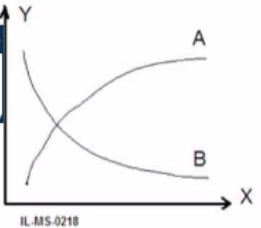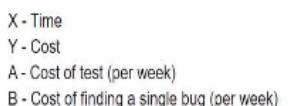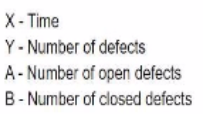ISTQB Certified Tester Foundation Level v4.0 ISTQB-CTFL Exam Practice Test
Match each objective to the correct test level
Objective:
A) Verifying whether the functional and non-functlonal behaviors of the system are as designed and specified.
B) Verifying whether the functional and non-functlonal behaviors of the interfaces are as designed.
C) Verifying whether the functional and non-functional behaviors of the components are as designed and specified.
D) Establishing confidence in the quality of the system as a whole.
Test Level:
1. Component testing.
2. Integration testing.
3. System testing.
4. Acceptance testing.
Answer : C
The test levels and their objectives can be matched as follows:
Verifying whether the functional and non-functional behaviors of the system are as designed and specified (A3: System testing).
Verifying whether the functional and non-functional behaviors of the interfaces are as designed (B2: Integration testing).
Verifying whether the functional and non-functional behaviors of the components are as designed and specified (C1: Component testing).
Establishing confidence in the quality of the system as a whole (D4: Acceptance testing).
Manager responsibilities in formal review includes ad except one of the following:
Answer : B
A formal review is a type of review that follows a defined process with formal entry and exit criteria and roles and responsibilities for participants. A formal review can have various roles involved, such as manager, moderator, author, reviewer and scribe. The manager responsibilities in formal review include all except one of the following:
Planning the review (correct responsibility)
Determines if the review objectives have been met (incorrect responsibility)
Decide on the execution of reviews (correct responsibility)
Allocate time for review (correct responsibility) The responsibility of determining if the review objectives have been met belongs to the moderator role, not to the manager role. Verified Reference: [A Study Guide to the ISTQB Foundation Level 2018 Syllabus - Springer], Chapter 3, page 28-29.
Match the Work Product with the category it belongs to:
Work Product: 1. Risk register 2 Risk information
3. Test cases
4. Test conditions
Category of work products:
A . Test planning work products
B . Test analysis work products.
C Test design work products
D . Test monitoring and control work products
Answer : A
Confirmation testing is performed after:
Answer : D
Confirmation testing is performed after a defect is fixed, and if such testing is successful then the regression tests that are relevant for such fix can be executed. Confirmation testing, also known as re-testing, is the process of verifying that a defect has been resolved by running the test case that originally detected the defect. Confirmation testing is usually done before regression testing, which is the process of verifying that no new defects have been introduced in the software as a result of changes or fixes. Therefore, option D is the correct answer.
A mid-size software product development company has analyzed data related to defects detected in its product and found out that detects fixed in earlier builds are getting re-opened after a few months.
The company management now seeks your advice in order to reverse this trend and prevent re-opening of defects fixed earlier.
What would be your FIRST recommendation to the company?
Answer : B
Regression testing is a type of testing that verifies that previously tested software still performs correctly after changes. Regression testing can help prevent re-opening of defects fixed earlier by ensuring that they do not cause any new failures or side effects. The first recommendation to the company is to verify existing regression test suite are adequate, and augment it, if required, in order to ensure that defects fixed earlier get re-tested in each subsequent build. This can help improve the coverage and effectiveness of regression testing and detect any regression defects as soon as possible. Automating existing test suites may also help reduce the time and effort required for regression testing, but this is not the first recommendation, as automation may not be feasible or cost-effective for all test cases. Analyzing the product modules containing maximum defects and getting them thoroughly tested and defects fixed as a one-time activity may also help reduce the defect density and improve the quality of those modules, but this is not the first recommendation, as it does not address the root cause of re-opening defects fixed earlier. Training or replacing the teams responsible for development and testing of the modules containing maximum number of defects may also help improve their skills or performance, but this is not the first recommendation, as it may not be necessary or appropriate for all teams. Verified Reference: [A Study Guide to the ISTQB Foundation Level 2018 Syllabus - Springer], Chapter 2, page 19; Chapter 4, page 45.
The following chart represents metrics related to testing of a project that was competed. Indicate what is represented by tie lines A, B and the axes X.Y

A)

B)

C)

D)
Answer : D
Option D correctly explains what is represented by the lines A, B and the axes X, Y in a testing metrics chart. According to option D:
X-axis represents Time
Y-axis represents Count
Line A represents Number of open bugs
Line B represents Total number of executed tests
This information is essential in understanding and analyzing the testing metrics of a completed project.
Which of the following characterizations applies to a test tool used for the analysis of a developer's code prior to its execution?
Answer : B
A test tool used for the analysis of a developer's code prior to its execution falls under the category of static testing tools. Static testing involves examining the code and documentation without executing the code. These tools are used to perform static analysis, which helps in identifying potential defects and code quality issues early in the development process. The ISTQB CTFL syllabus specifies that static analysis tools are essential for finding defects that do not manifest themselves during the execution of the program.